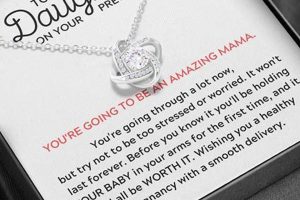Adorning infants with small decorative jewelry for the earlobes is a practice observed across various cultures. These diminutive ornaments, often made of precious metals, are typically secured through a piercing in the ear. The selection and placement of these items require careful consideration due to the delicate nature of a young child’s skin.
This practice holds symbolic value in many societies, representing cultural heritage, familial bonds, or even serving as a protective amulet. Historically, the material composition of the adornment could indicate familial wealth or status. Beyond mere ornamentation, it can be a tradition passed down through generations, marking a significant milestone in a childs life.
The following sections will explore crucial aspects related to this practice, including appropriate ages for piercing, materials that minimize allergic reactions, safety measures to prevent injury, and recommended aftercare procedures to ensure proper healing. Further discussion will involve the ethical considerations surrounding cosmetic procedures on infants.
Guidance for Infant Ear Adornment
Considerations for selecting and maintaining jewelry for an infant’s pierced ears necessitate careful attention to detail, prioritizing safety and minimizing potential complications. The following tips provide guidance for parents and guardians considering this practice.
Tip 1: Age of Piercing: Delay the piercing procedure until the infant has received initial vaccinations, typically around two months of age. This precaution minimizes the risk of infection during a period of heightened vulnerability.
Tip 2: Material Selection: Opt for hypoallergenic materials such as 14k gold, titanium, or surgical stainless steel. These materials significantly reduce the likelihood of allergic reactions and skin sensitivities.
Tip 3: Design Considerations: Choose designs that are small, lightweight, and devoid of sharp edges or dangling components. Secure screw-back closures are preferable to minimize the risk of accidental removal and potential choking hazards.
Tip 4: Professional Piercing: Ensure the piercing is performed by a licensed and experienced professional using sterile equipment and proper techniques. Reputable piercing studios adhere to strict hygiene standards and offer guidance on aftercare.
Tip 5: Aftercare Protocol: Follow the piercer’s instructions diligently regarding cleaning and maintenance. Typically, this involves cleaning the pierced area with a saline solution two to three times daily to prevent infection.
Tip 6: Monitoring and Observation: Regularly inspect the pierced area for signs of infection, such as redness, swelling, discharge, or tenderness. Promptly consult a pediatrician if any concerns arise.
Tip 7: Jewelry Maintenance: Periodically check the earring’s closure to ensure it remains secure. As the infant grows, reassess the size and fit of the adornment to prevent discomfort or potential injury.
Adherence to these guidelines promotes safe practices. Prioritizing material choice, design, professional execution, and diligent aftercare reduces complications and enhances the infant’s well-being.
Subsequent sections address parental considerations and safety regulations regarding infant jewelry.
1. Material Hypoallergenicity
The selection of materials exhibiting hypoallergenic properties is paramount when choosing ornamentation intended for infants’ earlobes. An infant’s skin is more permeable and reactive than that of an adult, rendering it susceptible to irritants and allergens. The primary cause of adverse reactions stems from nickel, a common component in many metal alloys. Contact with nickel can trigger allergic contact dermatitis, manifesting as redness, itching, swelling, and discomfort around the piercing site. Hypoallergenic materials mitigate this risk.
Stainless steel, titanium, and high-karat gold (14k or higher) are considered suitable due to their low nickel content and resistance to corrosion. For instance, surgical-grade stainless steel is frequently employed in medical implants due to its inertness and biocompatibility. Similarly, titanium’s oxide layer prevents metal ions from leaching onto the skin, reducing the likelihood of an allergic response. 14k gold, while containing some alloyed metals for durability, possesses a sufficiently high gold concentration to minimize reactivity. Real-world consequences of neglecting hypoallergenic materials range from localized skin irritation to chronic dermatitis requiring medical intervention.
Prioritizing material hypoallergenicity is thus a foundational principle in ensuring the safety and comfort of infants who undergo ear piercing. Challenges arise in verifying the precise composition of jewelry and educating caregivers about the potential risks of non-hypoallergenic materials. This principle directly links to the broader objective of minimizing preventable harm to infants and promoting their dermatological health during a sensitive developmental stage.
2. Closure Security
The security of the closure mechanism is a critical factor when selecting jewelry for infants’ ears. An inadequately secured closure presents potential hazards, including the risk of dislodgement, ingestion, and subsequent choking or gastrointestinal complications. The integrity of the closure directly impacts the infant’s safety.
- Screw-Back Mechanisms
Screw-back closures, characterized by a threaded post and a matching screw-on backing, offer enhanced security compared to friction-based alternatives. This design minimizes the likelihood of accidental loosening due to the infant’s movements or external forces. Real-world examples highlight instances where push-back or butterfly closures have detached, posing a choking hazard. The implication is that screw-back mechanisms should be the preferred option for infant ear adornments.
- Closure Material and Construction
The material composition and construction quality of the closure influence its durability and resistance to wear. Closures made from low-quality metals are prone to corrosion, weakening the mechanism and increasing the risk of failure. A robust closure, crafted from materials like surgical stainless steel or high-karat gold, ensures long-term reliability. The selection of durable materials and meticulous construction directly contributes to enhanced closure security.
- Regular Inspection and Maintenance
Even the most secure closure requires periodic inspection to identify potential issues such as loosening or damage. Parents and guardians should routinely check the closure to ensure it remains properly tightened. Real-world scenarios reveal that neglecting maintenance can lead to undetected closure failure, increasing the probability of the ornament becoming dislodged. Regular inspection and proactive maintenance are essential for maintaining the integrity of the closure.
- Design Minimization
A reduced size and simplified design of the earrings, particularly the closure components, can inherently enhance security. Bulky or intricate designs are more prone to catching on clothing or being manipulated by the infant, potentially leading to dislodgement. A streamlined, minimalist approach minimizes potential points of failure and contributes to overall closure security.
In summary, prioritizing closure security through the selection of appropriate mechanisms, durable materials, regular inspection, and minimized design is essential for safeguarding infants who wear ear adornments. These facets collectively contribute to minimizing the risk of dislodgement, ingestion, and associated health hazards, underscoring the significance of closure security in this context.
3. Size Appropriateness
The size of ear adornments intended for infants bears a direct relationship to safety, comfort, and prevention of complications. Selecting appropriately sized ornamentation minimizes the risks of tissue damage, obstruction, and accidental injury. The following facets delineate the considerations relevant to size appropriateness.
- Diameter and Length Dimensions
The overall diameter and length of earrings must be proportionate to the infant’s earlobe. Oversized earrings exert undue pressure, leading to potential skin irritation, inflammation, and even tissue necrosis. Conversely, excessively small earrings risk becoming embedded in the piercing site, necessitating medical intervention for removal. Dimensions should accommodate natural earlobe growth without constricting blood flow or causing discomfort.
- Weight Considerations
The weight of the earring contributes to the overall stress on the earlobe. Heavy earrings stretch the piercing site, increasing the risk of tearing or distortion. Lightweight materials, such as thin-gauge gold or titanium, are preferred to minimize gravitational pull and maintain the integrity of the earlobe tissue. Consideration of weight is particularly crucial in the initial weeks following piercing, as the tissue is more fragile and susceptible to damage.
- Proximity to Facial Features
Earring size influences proximity to other facial features, posing potential safety hazards. Earrings that extend too far from the earlobe may inadvertently come into contact with the infant’s eyes or mouth, increasing the risk of corneal abrasions or ingestion. A close, contained design minimizes the likelihood of external contact and associated injuries. The design should not protrude or dangle significantly from the ear.
- Developmental Stage Alignment
As infants develop, their motor skills and coordination improve, leading to increased manipulation of their surroundings. Earrings that are appropriate for a newborn may become unsuitable as the infant becomes more active and mobile. Parents and guardians must reassess earring size and design to accommodate the infant’s evolving developmental capabilities, ensuring that the chosen ornamentation remains safe and non-obstructive.
Adherence to size appropriateness criteria is paramount in mitigating the potential risks associated with jewelry on infants. Dimensions, weight, proximity to facial features, and developmental stage alignment are critical factors that collectively contribute to a safe and comfortable experience. Vigilant monitoring and adjustments are necessary throughout infancy to ensure continued safety and well-being.
4. Professional Piercing
The practice of piercing infants’ ears necessitates strict adherence to professional standards to mitigate potential risks and ensure optimal outcomes. Engaging qualified professionals is not merely a suggestion but a crucial prerequisite for safeguarding infant health and well-being.
- Sterile Environment and Equipment
Professional piercing establishments maintain stringent sterilization protocols to prevent infection transmission. Autoclaves, utilized for sterilizing instruments, eliminate bacteria, viruses, and other pathogens. Single-use needles further minimize cross-contamination risks. In contrast, non-professional settings often lack appropriate sterilization measures, exposing infants to potentially severe infections, including staphylococcus or even bloodborne pathogens. Professionals adhere to rigorous sanitation standards, ensuring a safe environment.
- Proper Technique and Precision
Experienced piercers possess anatomical knowledge crucial for precise placement, minimizing the risk of nerve damage or misalignment. They utilize specialized tools designed for infant earlobes, ensuring a clean and accurate puncture. Inadequate technique, often seen in non-professional settings, can result in uneven piercings, prolonged healing times, and potential scarring. Precise placement is essential for minimizing discomfort and long-term complications.
- Appropriate Jewelry Selection and Application
Professionals guide parents in selecting appropriate jewelry, considering material, size, and closure security. They possess the expertise to properly apply jewelry, ensuring a secure fit without causing undue pressure or irritation. Inexperienced individuals may select unsuitable jewelry or improperly secure the closure, increasing the risk of dislodgement, ingestion, or allergic reactions. Professional guidance is paramount for safe and comfortable jewelry selection.
- Comprehensive Aftercare Instructions and Support
Licensed piercers provide detailed aftercare instructions, including cleaning protocols, signs of infection, and contact information for follow-up care. They offer ongoing support and address parental concerns, facilitating proper healing and minimizing complications. The lack of aftercare guidance in non-professional settings can lead to improper wound care, increasing the risk of infection and delayed healing. Professional support is crucial for ensuring optimal outcomes and addressing potential complications.
Engaging a professional piercer constitutes a significant investment in infant safety and well-being. While alternative options may appear more convenient or cost-effective, the potential risks associated with non-professional piercing far outweigh any perceived benefits. Adherence to professional standards is a non-negotiable prerequisite for responsible and ethical ear piercing practices in infants. These standards provide a strong start when parents adorn a child with baby first earrings.
5. Aftercare Diligence
The connection between aftercare diligence and the practice of adornment is causal and critical. Diligent aftercare directly influences the healing process, reduces the incidence of infection, and promotes long-term tissue health. Conversely, neglecting aftercare protocols elevates the risk of complications, ranging from localized inflammation to systemic infections, potentially necessitating medical intervention. The success, comfort, and safety surrounding infant ear piercing are inextricably linked to consistent and conscientious aftercare practices. This diligence forms an indispensable element of responsible implementation.
The practical implications of aftercare diligence are multifaceted. Cleaning the pierced area with a sterile saline solution two to three times daily removes debris and inhibits bacterial growth. Gentle rotation of the earring prevents tissue adhesion and promotes circulation. Monitoring for signs of infection, such as redness, swelling, or discharge, allows for early detection and intervention. Real-world examples abound: infants whose piercings are diligently cleaned experience faster healing and fewer complications compared to those whose aftercare is inconsistent. Parents who promptly address early signs of infection prevent the progression to more severe conditions. A failure to practice the recommended hygiene regime might lead to longer healing periods.
In summary, aftercare diligence constitutes a cornerstone of safe and responsible jewelry for infants. The practice mitigates infection risks, promotes healing, and ensures long-term tissue health. Challenges exist in educating and motivating caregivers to consistently adhere to aftercare protocols. However, the benefits of diligent aftercare far outweigh the effort required, making it an indispensable component of ethical practices. Prioritizing aftercare exemplifies a commitment to infant well-being and minimizes preventable harm.
6. Age Considerations
Age considerations exert a profound influence on the safety and suitability of infant ear adornment. The chronological age and developmental stage of the infant directly impact tissue fragility, immune system maturity, and the capacity to communicate discomfort. A younger infant possesses more delicate skin and a less developed immune system, rendering them more vulnerable to infection and adverse reactions. Premature piercing increases the risk of complications.
Delaying the procedure until after the initial vaccination series, typically around two months of age, provides partial immune protection against potential infections. Furthermore, an older infant may exhibit improved head control, reducing the likelihood of accidental trauma during the piercing process. Real-world instances document cases of severe infections and scarring resulting from piercing infants who were too young or had compromised immune systems. Ethically, age considerations reflect the principle of minimizing potential harm to vulnerable individuals. Postponing or refraining from piercing entirely prioritizes the infant’s immediate safety and well-being, deferring to their future autonomy to make decisions about their bodies.
Age, therefore, acts as a determining factor influencing both the feasibility and ethical permissibility. Challenges arise in balancing cultural traditions with the prioritization of infant health. Caregivers must be educated on the inherent risks associated with early piercing and empowered to make informed decisions that align with their child’s best interests. Linking age to safety necessitates a comprehensive approach that considers physiological development, immune status, and ethical obligations, ensuring that decisions regarding infant ear adornment are grounded in the principle of non-maleficence.
Frequently Asked Questions about Baby First Earrings
This section addresses common inquiries and misconceptions surrounding the practice of ear piercing and the selection of appropriate adornments for infants. The intent is to provide clear, concise, and evidence-based information to assist caregivers in making informed decisions.
Question 1: At what age is it generally considered safe to pierce an infant’s ears?
While cultural practices vary, many medical professionals advise delaying ear piercing until after the infant has received their initial vaccinations, typically around two months of age. This precaution minimizes the risk of infection during a period of heightened vulnerability.
Question 2: What materials are most suitable for infants, minimizing the risk of allergic reactions?
Hypoallergenic materials such as 14k gold, titanium, or surgical stainless steel are recommended. These materials possess a low nickel content, reducing the likelihood of allergic contact dermatitis.
Question 3: What closure types offer the most security and minimize the risk of accidental dislodgement?
Screw-back closures provide a more secure fit compared to push-back or butterfly closures. The threaded post and screw-on backing reduce the risk of accidental loosening and potential ingestion.
Question 4: How should the pierced area be cleaned to prevent infection?
The pierced area should be cleaned two to three times daily with a sterile saline solution. Gently rotate the earring to prevent tissue adhesion. Monitoring for signs of infection, such as redness, swelling, or discharge, is also crucial.
Question 5: What steps should be taken if an infection is suspected?
If signs of infection are present, consult a pediatrician promptly. Early intervention is essential to prevent the infection from progressing to more severe conditions.
Question 6: How often should the earrings be checked to ensure proper fit and security?
Earrings should be checked regularly to ensure the closure remains secure and the size is appropriate for the infant’s earlobe. As the infant grows, adjustments may be necessary to prevent discomfort or injury.
Prioritizing safety, material selection, closure security, and diligent aftercare are paramount when considering ear piercing and adornment for infants. Seeking professional guidance and adhering to recommended practices contribute to optimal outcomes.
The subsequent section will address potential complications and warning signs associated with infant ear piercing.
Conclusion
This exploration of baby first earrings has underscored the multifaceted considerations inherent in this practice. Key aspects include stringent material selection, secure closure mechanisms, appropriately sized designs, the imperative of professional piercing services, and diligent aftercare protocols. These elements collectively contribute to mitigating potential risks and promoting infant well-being.
The decision to adorn an infant with baby first earrings is not without consequence and warrants careful deliberation. Prioritizing safety, informed consent (when possible), and ethical considerations remains paramount. A proactive approach, emphasizing preventative measures and responsible practices, will best safeguard the health and comfort of the infant. Future research should focus on refining best practices and developing even safer materials and techniques for infant ear adornment.







